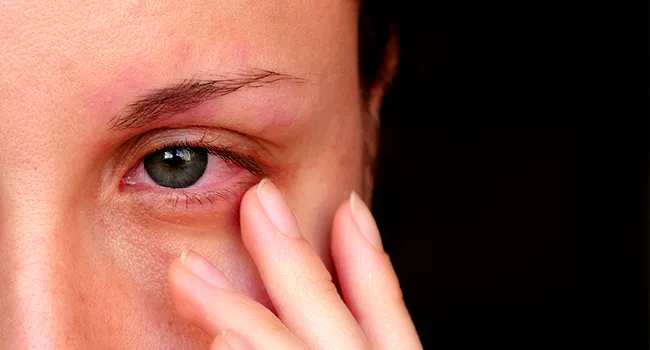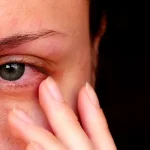Watery eyes, also known as epiphora, occur when tears overflow from the eyes due to excessive production or inadequate drainage. While tears are essential for lubricating the eyes and maintaining clear vision, an imbalance in tear production can cause discomfort, blurred vision, and irritation.
In most cases, watery eyes are a temporary and minor issue. However, when excessive tearing persists, it can indicate an underlying condition that requires attention. Understanding the potential causes, symptoms, and treatments is crucial for managing this condition effectively.
Causes of Watery Eyes
Overproduction of Tears
Excessive tear production can result from environmental irritants like wind, smoke, or bright light. The body may produce extra tears as a defence mechanism against these irritants. For instance, exposure to cold weather or strong winds often triggers a reflex response, leading to watery eyes.
Some individuals may experience watery eyes due to allergic reactions to pollen, dust, or pet dander. Seasonal allergies, commonly known as hay fever, can cause persistent eye irritation, leading to excessive tearing, itchiness, and redness.
Blocked Tear Ducts
Tears usually drain through small ducts in the inner corners of the eyes. When these ducts become blocked due to infections, inflammation, or congenital conditions, tears cannot drain properly, leading to overflow.
A blocked tear duct can occur at any age, but it is more common in newborns and older adults. In infants, the tear ducts may not be fully developed, causing tears to accumulate. In older adults, the tear ducts may narrow over time due to inflammation or infections, leading to chronic tearing.
Eye Infections and Inflammation
Conditions such as conjunctivitis (pink eye) and blepharitis (eyelid inflammation) can irritate the tear glands, prompting excessive tear production. Bacterial or viral infections can lead to inflammation and increased tear production as the body attempts to flush out the irritants.
Blepharitis, a chronic condition affecting the eyelids, can result in blocked oil glands near the eyelashes, causing irritation and excessive tearing. Treating the underlying infection or inflammation is essential for managing watery eyes.
Foreign Objects and Eye Strain
Particles such as dust, dirt, or eyelashes can trigger excessive tearing as a protective response. The eyes naturally produce more tears to flush out foreign substances and prevent damage to the cornea.
Additionally, prolonged screen exposure and eye fatigue can contribute to watery eyes. Staring at digital screens for extended periods reduces blinking frequency, leading to dry and irritated eyes. This, in turn, can cause reflex tearing, where the eyes produce excess tears to compensate for dryness.
Symptoms of Watery Eyes
Persistent Tearing
Watery eyes often cause constant tear overflow, which can blur vision and lead to discomfort. Depending on the underlying cause, this symptom may be mild or severe.
Redness and Irritation
Excessive tearing can result in red, swollen eyelids and a burning sensation. Irritation may worsen when exposed to allergens, wind, or bright light.
Sensitivity to Light
Individuals with watery eyes may find bright lights uncomfortable, further exacerbating tear production. Photophobia, or light sensitivity, is commonly associated with eye infections, inflammation, and excessive tearing.
Watery Eyes Diagnosis
Eye Examination
An eye specialist may conduct a detailed examination to assess the underlying cause of watery eyes. This may include checking for signs of infection, blockages, or abnormalities in tear production.
Tear Drainage Test
A tear drainage test involves using dye to observe how quickly tears drain from the eyes. This helps determine whether a blockage is present. If the dye remains on the eye’s surface for an extended period, it may indicate a tear duct obstruction.
Watery Eyes Treatment
Home Remedies
Warm Compresses
Applying a warm compress can help unclog tear ducts and reduce inflammation. Putting a clean, warm cloth over the eyes for a few minutes can also promote better tear drainage and relieve discomfort.
Proper Eye Hygiene
Cleaning the eyelids regularly can prevent infections and reduce irritation. Using gentle cleansers and avoiding rubbing the eyes can help maintain eye health.
Hydration and Diet
Maintaining hydration and consuming a balanced diet of omega-3 fatty acids can promote eye health. Foods such as fish, nuts, and flaxseeds contain essential nutrients that support tear production and overall eye function.
Medications
Lubricant eye drops:
These drops optimize the quality of the tears & stabilise the tear film. They also reduce irritation & reflex tearing.
Antihistamines
Antihistamines can reduce inflammation and tear production in allergy-related watery eyes. They help block histamine release, alleviating symptoms such as itching and excessive tearing.
Antibiotics
Bacterial infections causing watery eyes may require prescription antibiotic eye drops. Treating the infection promptly can prevent complications and reduce excessive tearing.
Surgical Options
Tear Duct Surgery
A minor surgical procedure called dacryocystorhinostomy (DCR) can create a new drainage pathway for blocked tear ducts. This procedure is often recommended for individuals with chronic tear duct obstructions.
Punctal Plugs
In cases where dry eyes lead to reflex tearing, punctual plugs may be inserted to regulate tear flow. These tiny devices help retain moisture in the eyes, reducing excessive tearing caused by dryness.
Prevention Techniques for Watery Eyes
Avoiding Irritants
Reducing exposure to smoke, dust, and allergens can help minimise excessive tear production. Wearing protective eyewear and keeping indoor environments clean can prevent irritation.
Screen Time Management
Taking breaks from screens and practising the 20-20-20 rule (looking away from the screen every 20 minutes at an object 20 feet away for 20 seconds) can reduce eye strain and prevent reflex tearing.
Protective Eyewear
Sunglasses can shield the eyes from wind and bright light, reducing excessive tearing. UV protection can also help prevent irritation caused by prolonged sun exposure.
Conclusion
Watery eyes can result from various causes, including environmental factors, infections, and blocked tear ducts. Proper diagnosis and treatment can help manage symptoms effectively. If persistent tearing affects daily activities, consulting an eye specialist is recommended.
Start relieving your eye discomfort today. Schedule an appointment with an eye specialist for a personalised evaluation and treatment plan. Book Here
FAQs
Answer: Yes, certain medications, especially those with ocular side effects, can contribute to watery eyes.
Answer: Blocked tear ducts, allergies, cornea problems, eyelid inflammation, and various eye conditions can lead to watery eyes.
Answer: Natural treatments include warm compresses, staying hydrated, and managing allergies or underlying health issues.
Answer: Yes, watery eyes home remedies include warm compresses, maintaining eye hygiene, and using artificial tears for mild cases.
Answer: Yes, allergens like pollen, dust, or pet dander can trigger excessive tear production, leading to watery eyes.
Answer: Yes, stress and fatigue can contribute to watery eyes by disrupting the normal tear production and drainage balance.
Article: What Causes Watery Eyes and How to Treat Them
Author: CFS Editorial Team | Feb 05 2021 | UPDATED 02:20 IST
Excessive tearing in one eye may result from a blocked tear duct, infection, or irritation from a foreign object. An eye exam can help identify the exact cause.
Yes, allergies can trigger excessive tear production due to histamine release in response to allergens. Managing allergies with medications and avoiding triggers can help reduce symptoms.
Using warm compresses, maintaining good eye hygiene, and avoiding allergens can help manage watery eyes naturally. Drinking plenty of water and consuming nutrient-rich foods also support eye health.





